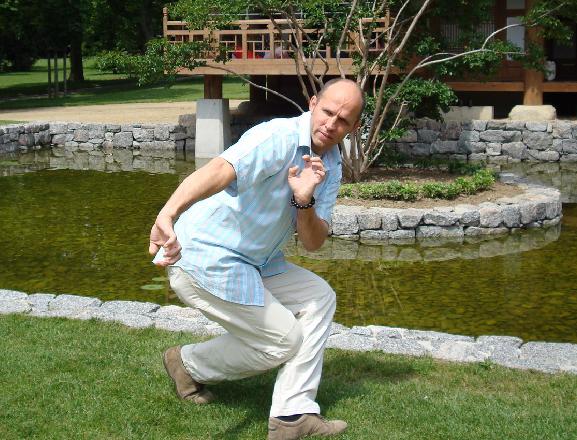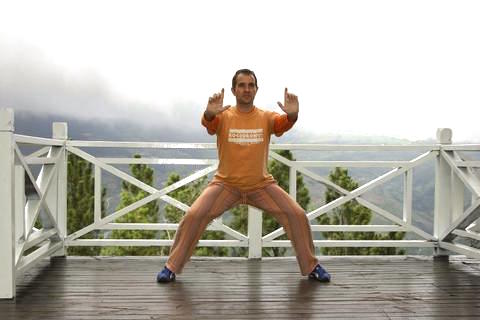August 2007 (Part 2)
SELECTION OF QUESTIONS AND ANSWERS

Sifu Kai Uwe Jettkandt posing in a Shaolin Kungfu pattern
Question 1
I have for many years been very interested in martial arts particularly Shaolin Kung Fu. But due to my religious beliefs when I was younger I was not allowed to take up a martial art. But after many years in this religion, I decided this was wrong and not what I wanted to do with my life, I am very keen to get started learning kung fu not for fighting but for my well being and health, and perhaps to help give me some direction in life.
— Mark, UK
Answer
You may be pleased to know that both Shaolin Kungfu and Taijiquan started as training for spiritual fulfillment. The great Bodhidharma tuaght the monks at the Shaolin Monastery the Eighteen Lohan Hands to help them attainment Enlightenment. Later Eightenn Lohan Hands developed into Shaolin Kungfu.
The great Zhang San Feng practiced Shaolin Kungfu on the Wudang Mountain to attain the Tao. His chi flow movements due to his Shaolin training were stylized into patterns which later developed into Taijiquan.
Hence, Shaolin Kungfu and Taijiquan were originally practiced not because the practitioners want to be formidable fighters but because they wanted to attain Enlightenment or attaining the Tao. Attaining Enlightenment and attaining the Tao are what Christians mean as returning to God the Holy Spirit.
It is important to bear in mind that attaining Enlightenment and attaining the Tao are spiritual, but non-religious. They refer to the greatest spiritual attainment any beings can achieve, and can be practiced and achieved by persons of any religion or of no particular religion.
Other kungfu styles, however, did not start as spiritual cultivation, although some of their practitioners are highly spiritual. These other kungfu styles were trained for combat efficiency.
Question 2
I am really looking for some advice as to where I should start, and what type of kung fu should I start.
Answer
If your main aims of practicing kungfu are for well being and health as well as directions in life, the best choice is either genuine, traditional Shaolin Kungfu or genuine, traditional Taijiquan. I would stress the two words “genuine” and “traditional”. Many people may be angry at what I have to say, but it is true that most of Shaolin Kungfu and Taijiquan practiced today is not “genuine” and “traditional”.
The three criteria that mark genunie, traditional Shaolin Kungfu and genuine, traditional Taijiquan are that they are combat effective, develop internal force and involve spiritual cultivation. Most practitioners of Shaolin Kungfu and Taijiquan today do not even attain any one of these criteria. They cannot use their Shaolin Kungfu or Taijiquan for combat, have no internal force and no spiritual experiences.
Genuine, traditional Shaolin Kungfu and genuine, traditional Taijiquan are very rare today. Even if you manage to find these rare masters, they may not want to teach you.
We may sound very boastful or egoistic, but it is true that we can use our Shaolin Kungfu and Taijiquan for combat, we develop internal force, and we have wonderful spiritual experiences. If others choose not to believe us, that is their right and privillege, and we have neither intention nor interest to convince them. But we just want to state the truth.
We are quite open in accepting willing students, provided they are deserving and follow the Ten Shaolin Law. Indeed, some of our instructors find that the easy way we accept students, and the generous manner we teach them, quite ridiculous — in a good sense. If you wish to learn from us, please refer to our List of Certified Instructors. If you wish to learn from me, please check the dates on my website for my intensive or regional courses.
Of course, you can learn from other genuine masters. But first you have to define your aims and objectives, and then search for a master who can help you realize them. Most important, you have to practice diligently according to how he asks you to practice — not according to what and how you think you should practice.

Ho and Geoffrey practicing Taijiquan combat application during an Intensive Taijiquan Course
Question 3
I did attend a kung fu class for 6 months but found the teacher looking more like he wanted to cause the new students pain and show off to the older students.
Answer
Your experience with the kungfu teacher is not uncommon. His attitude is not that of traditional kungfu. He was probably influenced by other martial arts where the philosophy includes tenets like “win at all cost” and “no pain, no gain”. Traditional kungfu philosophy values tenets like “safety first, winning is secondary” and “training should contribute, not deter from, health”.
Question 4
I am 63 years old & suffer from Parkinsons Disease. Is there any hope for this?
— Maureen, UK
Answer
Yes, there is good hope to recover if you practice high level chi kung. Some of our students suffered from Parkinsons Disease before, but they were cured after practicing Shaolin Cosmos Chi Kung learnt from us.
From the chi kung perspective, Parkinsons Disease, like all other diseases, is due to energy blockage. Mental impulses, which carry instructions to muscles, are blocked from reaching their destinations. The chi flow from high level chi kung can clear the blockage, thus overcome the disease.

Alejandro of Shaolin Wahnam Spain perfroming “Golden Bridge” in Sabah suring an Intensive Shaolin Kungfu Course in March 2007
Question 5
I have been practicing Chen Taiji for the past 3 months with a reputable master. He emphasized to me to train the Three-Circle Taiji Energy Stance to develop internal power and solid stance. I have been gradually working up to it, (can do about 7 minutes) but have had difficulty with the abdominal breathing. He points out that I tend to trap qi in my chest or throat, and that the qi needs sink down into the dan-tien. Also, he asks me to tilt my hips forward and bend at the lumbar region, and to concentrate on my kidneys when doing the exercise.
— Tony, USA
Answer
Your master gave you good advice. Spend some time over your Three-Circle Stance. Not only you will have internal force which will greatly improve your Taijiquan performance, you will also be healthy and full of vitality. You should aim at a minimum of 15 minutes, but you should progress gradually and enjoy your training along the way.
Question 6
When I practice the stance, is it necessary to tighten my abdominal muscles before I breathe in gently? I find that if I use my entire stomach (everything below lungs) to breathe, I feel more comfortable, but I am not sure if this is correct? But when I do tighten my abdominal muscles, the breathing is a lot slower, and more concentrated. I do not know which is correct?
Answer
Different schools and different masters have different ways to teach the stances. In our school, we do not worry about the breathing, and we do not tighten any muscles, including the abdominal muscles. In other words, breathe naturally and relax, including to relax all your muscles.
In our school, there are only two steps in practicing the Three-Circle Stance and any other stances. The two steps are simple, but that does not necessarily mean easy.
First, get the form correct. In particular, make sure your body is upright. We do not worry about tugging in the tail bone, tilting the hips forward or concentrating at the kidneys.
Two, relax, relax and relax. This means we do not tighten any muscles, and do not worry about our breathing.

The Three-Circle Stance
Question 7
Is it advisable to train both Three-Circle Stance and Golden Bridge concurrently? In your book, you mentioned that Three-Circle Stance focuses more on qi (energy) development, whereas Golden Bridge focuses more on jing (essence) development.
Answer
No, it is inadvisable to train both these two stances concurrently, especially when you are at the beginner's level. It is not harmful, but your progress is more if you focus on just one stance. This does not mean you do not learn and practice the other stances, but you focus only on one. Relatively speaking, Taijiquan focuses on qi, and Shaolin focuses on jing. Therefore, if you practice Taijiquan, training the Three-Circle Stance which focuses on qi is more cost-efective than training the Golden Bridge.
This does not mean that training the Golden Bridge is not beneficial, but it is relatively less cost-effective. Let us take an example of four Taijiquan students. Presume that all other things were equal, but A trains only Golden Bridge, B trains only Three-Circle Stance, C trains both Golden Bridge and Three-Circle Stance, and D does not train any stances. In terms of power, the listing from the strongest to the weakest will be A, B, C, D. But in terms of proficiency in Taijiquan the listing will be B, C, A, D.
Why is A only the third proficient when he is the most powerful? It is because power, while important, is not the only factor to determine Taijiquan proficiency. Relatively, qi is more important than jing in Taijiquan; hence, although B may be less powerful than A, he is more proficient.
An analogy may make things clearer. Suppose you have US$ 1000 (which is about 750 Euros at the time of writing), and your friend has only 500 Euros (about US$ 680) But when you are in Europe, your friend will be more proficient in making purchases. If the four students practiced Shaolin Kungfu instead of Taijiquan, the listing would be different. In terms of power, the listing would be A, C, B, D. In terms of Shaolin proficiency, the listing would be A, C, B, D too. When you are back in the United States, your US$ 1000 will be more proficient than your friend's 500 Euros.
Question 8
Is it counter-productive or harmful to use Shaolin training techniques (i.e. Golden Bridge, Lifting the Sky), while studying Chen Taijiquan?
Answer
No, it is neither counter-productive nor harmful. In fact, Chen Taijiquan techniques, including all the stances, are found in Shaolin. Chen masters chose from the extensive Shaolin repertoire those techniques that gave them the best advantages.
LINKS
Selected Reading
- Skills derived from Sparring can be Rewardingly used in Daily Life
- The Chinese Sword against the Samurai Sword and the Staff
- The Wonders of Tantui Sequence 1
- The Blue Mountain
- Principles and Practice, Insight and Integrity
